Tutorial: Order Azure Data Box Heavy
Azure Data Box Heavy is a hybrid solution that allows you to import your on-premises data into Azure in a quick, easy, and reliable way. You transfer your data to a Microsoft-supplied 770 TB (approximate usable capacity) storage device and then ship the device back. This data is then uploaded to Azure.
This tutorial describes how you can order an Azure Data Box Heavy. In this tutorial, you learn about:
- Prerequisites for Data Box Heavy
- Order a Data Box Heavy
- Track the order
- Cancel the order
Prerequisites
Complete the following configuration prerequisites for Data Box service and device before you deploy the device.
For installation site
Before you begin, make sure that:
- The device fits through standard doorways and entryways. However, do make sure that the device can fit through all your entryways. Device dimensions are: width: 26" length: 48" height: 28".
- If installed on a floor other than the ground floor, you need access for the device via an elevator or a ramp. The device weighs approximately ~500 lbs.
- Make sure that you have a flat site in the datacenter with proximity to an available network connection that can accommodate a device with this footprint.
For service
Before you begin, make sure that:
You have your Microsoft Azure storage account with access credentials, such as storage account name and access key.
The subscription you use for Data Box service is one of the following types:
- Microsoft Customer Agreement (MCA) for new subscriptions or Microsoft Enterprise Agreement (EA) for existing subscriptions. Read more about MCA for new subscriptions and EA subscriptions.
- Cloud Solution Provider (CSP). Learn more about Azure CSP program.
Note
This service is supported for the Azure CSP program in India if you are on the modern billing model. If you are on the legacy billing model as per your agreement, you will not be able to create Data Box orders.
- Microsoft Azure Sponsorship. Learn more about Azure sponsorship program.
- Microsoft Partner Network (MPN). Learn more about Microsoft Partner Network.
Ensure that you have owner or contributor access to the subscription to create a device order.
For device
Before you begin, make sure that:
Your device is unpacked.
You should have a host computer connected to the datacenter network. Data Box Heavy will copy the data from this computer. Your host computer must run a supported operating system as described in Azure Data Box Heavy system requirements.
You need to have a laptop with RJ-45 cable to connect to the local UI and configure the device. Use the laptop to configure each node of the device once.
Your datacenter needs to have high-speed network. We strongly recommend that you have at least one 10-GbE connection.
You need one 40-Gbps or 10-Gbps cable per device node. Choose cables that are compatible with the Mellanox MCX314A-BCCT network interface:
- For the 40-Gbps cable, device end of the cable needs to be QSFP+.
- For the 10-Gbps cable, you need an SFP+ cable that plugs into a 10 G switch on one end, with a QSFP+ to SFP+ adapter (or the QSA adapter) for the end that plugs into the device.
- The power cables are included with the device.
Order Data Box Heavy
To order and device, perform the following steps in the Azure portal:
Use your Microsoft Azure credentials to sign in at this URL: https://portal.azure.com.
Select + Create a resource and search for Azure Data Box. Select Azure Data Box.

Select Create.
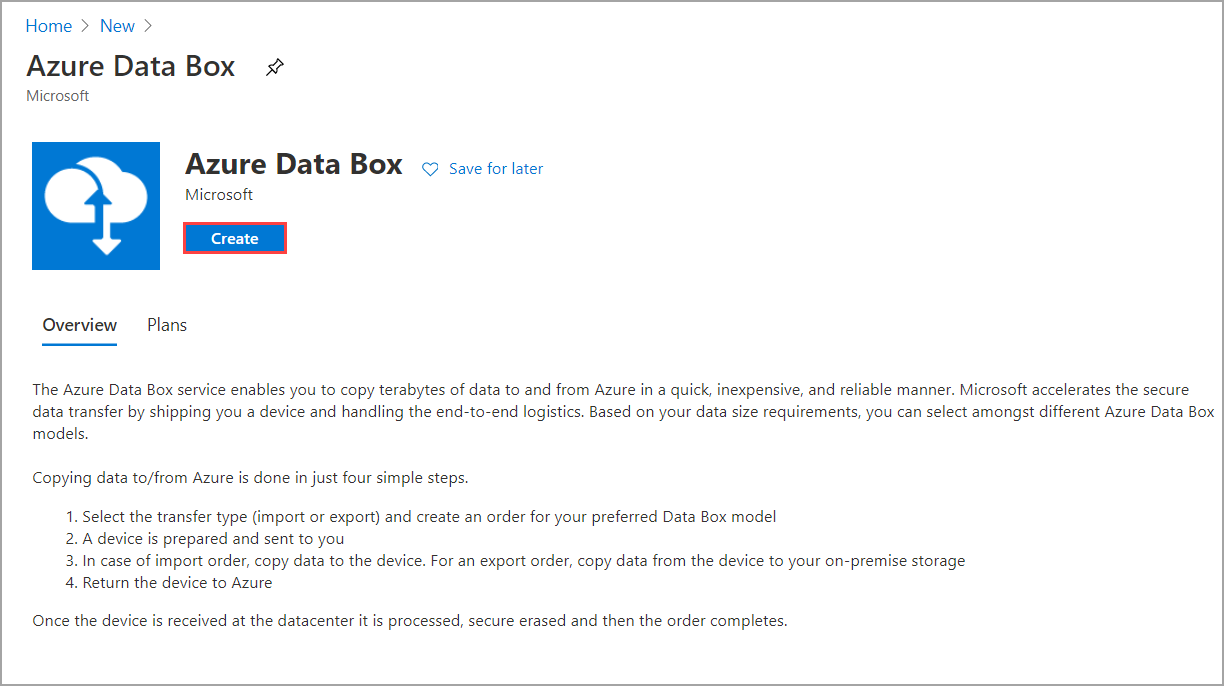
Check whether Data Box service is available in your region. Enter or select the following information, and then select Apply.
Setting Value Transfer type Select Import to Azure. Subscription Select an Enterprise Agreement (EA), Cloud Solution Provider (CSP), or Azure sponsorship subscription for Data Box service.
The subscription is linked to your billing account.Resource group Select an existing resource group. A resource group is a logical container for the resources that can be managed or deployed together. Source country/region Select the country/region where your data currently resides. Destination Azure region Select the Azure region where you want to transfer data.
For more information, see region availability for Data Box or region availability for Data Box Heavy.
If the selected source and destination regions cross international country/region borders, Data Box and Data Box Heavy aren't available.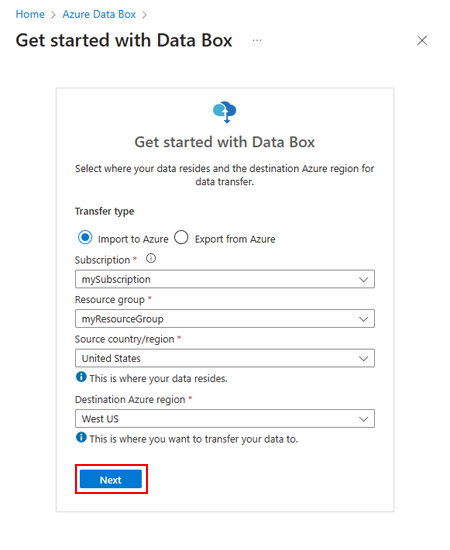
Select the Data Box product to order, either Data Box, as shown in the provided example, or Data Box Heavy.
The maximum usable capacity for a single Data Box order is 80 TB. The maximum usable capacity for a single Data Box Heavy order is 770 TB. You can create multiple orders to accommodate larger data sizes.
You can't select either Data Box or Data Box Heavy if:
Your selected source and destination regions cross international country/region boundaries.
To transfer your data across country/region borders, import your data to a destination within the same country/region. After the data import completes, use Azure Import/Export to transfer the data to your desired country/region.
Your Azure subscription doesn't support the Data Box product. In some cases, your subscription might not support a Data Box product in a specific country/region.
If you select Data Box Heavy, the Data Box team checks device availability within your region and notifies you when you can continue placing the order.
In Order, go to the Basics tab. Enter or select the following information. Then select Next: Data destination>.
Setting Value Subscription The subscription is automatically populated based on your earlier selection. Resource group The resource group you selected previously. Import order name Provide a friendly name to track the order. - The name can have between 3 to 24 characters that can be a letter, number, or hyphen.
- The name must start and end with a letter or a number.

On the Data destination screen, select the Data destination - either storage accounts or managed disks.
The Data destination tab changes based on your selected destination. See either To use storage accounts or To use managed disks in the following section for instructions.
To use storage accounts
Select storage account(s) as the storage destination. The following screen is displayed.

Based on the specified Azure region, select one or more storage accounts from the filtered list of existing storage accounts. Your Data Box can be linked with up to 10 storage accounts. You can also create a new General-purpose v1, General-purpose v2, or Blob storage account.
If you select Azure Premium FileStorage accounts, the provisioned quota on the storage account share increases to the size of data being uploaded to the file shares. After the quota is increased, it isn't adjusted again, for example, if for some reason the Data Box can't upload your data.
This quota is used for billing. After your data is uploaded to the datacenter, you should adjust the quota to meet your needs. For more information, see Understanding billing.
If you're using a General Purpose v1, General Purpose v2, or Blob storage account, the Enable copy to archive option is shown. Enabling Copy to archive allows you to send your blobs to the archive tier automatically. Any data uploaded to the archive tier remains offline and needs to be rehydrated before it can be read or modified.
When Copy to archive is enabled, an extra
Archiveshare is available during the copy process. The extra share is available for SMB, NFS, REST, and data copy service methods.
Note
Storage accounts with virtual networks are supported. To allow the Data Box service to work with secured storage accounts, enable the trusted services within the storage account network firewall settings. For more information, see how to Add Azure Data Box as a trusted service.
To use managed disks
When using Data Box to create Managed disk(s) from on-premises virtual hard disks (VHDs), you also need to provide the following information:
Setting Value Resource groups Create new resource groups if you intend to create managed disks from on-premises VHDs. You can use an existing resource group only if the resource group was created previously when creating a Data Box order for managed disks by the Data Box service.
Specify multiple resource groups separated by semi-colons. A maximum of 10 resource groups are supported.
The storage account specified for managed disks is used as a staging storage account. The Data Box service uploads the VHDs as page blobs to the staging storage account before converting the page blobs to managed disks and moving them to the resource groups. For more information, see Verify data upload to Azure.
Note
Data Box supports copying only 1 MiB aligned, fixed-size
.vhdfiles for creating managed disks. Dynamic VHDs, differencing VHDs,.vmdkor.vhdxfiles are not supported.If a page blob isn't successfully converted to a managed disk, it stays in the storage account and you're charged for storage.
Select Next: Security> to continue.
The Security screen lets you use your own encryption key and your own device and share passwords, and choose to use double encryption.
All settings on the Security screen are optional. If you don't change any settings, the default settings are applied.

If you want to use your own customer-managed key to protect the unlock passkey for your new resource, expand Encryption type.
Configuring a customer-managed key for your Azure Data Box is optional. By default, Data Box uses a Microsoft managed key to protect the unlock passkey.
A customer-managed key doesn't affect how data on the device is encrypted. The key is only used to encrypt the device unlock passkey.
If you don't want to use a customer-managed key, skip to Step 15.

To use a customer-managed key, select Customer managed key as the key type. Then choose Select a key vault and key.

On the Select key from Azure Key Vault pane:
The Subscription is automatically populated.
For Key vault, you can select an existing key vault from the dropdown list.

Or select Create new key vault if you want to create a new key vault.

Then, on the Create key vault screen, enter the resource group and a key vault name. Ensure that Soft delete and Purge protection are enabled. Accept all other defaults, and select Review + Create.

Review the information for your key vault, and select Create. Wait for a couple minutes for key vault creation to complete.
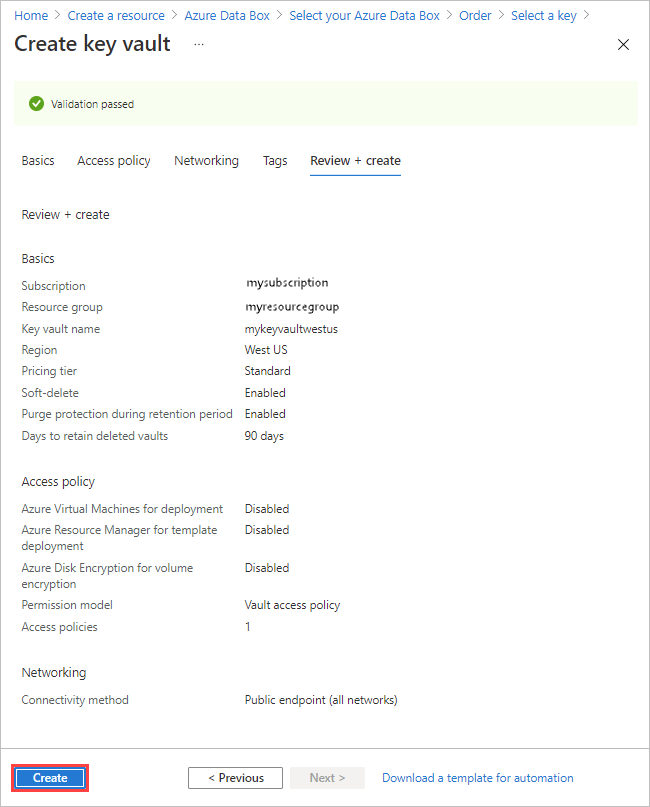
The Select a key pane displays your selected key vault.

If you want to create a new key, select Create new key. You must use an RSA key. The size can be 2048 or greater. Enter a name for your new key, accept the other defaults, and select Create.

You're notified when the key is created in your key vault. Your new key is selected within the Select a key pane.
Select the Version of the key to use, and then choose Select.

If you want to create a new key version, select Create new version.

Choose settings for the new key version, and select Create.

The Encryption type settings on the Security screen show your key vault and key.

Select a user identity with which to manage access to this resource. Choose Select a user identity. In the panel on the right, select the subscription and the managed identity to use. Then choose Select.
A user-assigned managed identity is a stand-alone Azure resource that can be used to manage multiple resources. For more information, see Managed identity types.
If you need to create a new managed identity, follow the guidance in Create, list, delete, or assign a role to a user-assigned managed identity using the Azure portal.

The user identity is shown in Encryption type settings.
 :
:Important
If you use a customer-managed key, you must enable the
Get,UnwrapKey, andWrapKeypermissions on the key. Without these permissions, order creation will fail. They're also needed during data copy. To set the permissions in Azure CLI, see az keyvault set-policy.If you don't want to use the system-generated passwords that Azure Data Box uses by default, expand Bring your own password on the Security screen.
The system-generated passwords are secure, and are recommended unless your organization requires otherwise.

- To use your own password for your new device, by Set preference for the device password, select Use your own password, and type a password that meets the security requirements.
The password must be alphanumeric and contain between 12 to 15 characters. It must also contain at least one uppercase letter, one lowercase letter, one special character, and one number.
- Allowed special characters: @ # - $ % ^ ! + = ; : _ ( )
- Characters not allowed: I i L o O 0

To use your own passwords for shares:
By Set preference for share passwords, select Use your own passwords and then Select passwords for the shares.
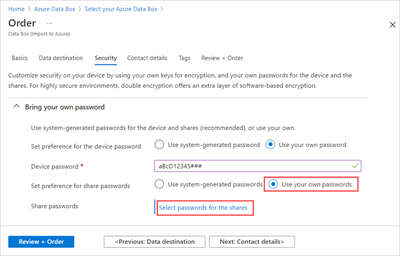
Type a password for each storage account in the order. The password is used on all shares for the storage account.
The password must be alphanumeric and contain between 12 to 64 characters. It must also contain at least one uppercase letter, one lowercase letter, one special character, and one number.
- Allowed special characters: @ # - $ % ^ ! + = ; : _ ( )
- Characters not allowed: I i L o O 0
To use the same password for all of the storage accounts, select Copy to all.
When you finish, select Save.

On the Security screen, you can use View or change passwords to change the passwords.
In Security, if you want to enable software-based double encryption, expand Double-encryption (for highly secure environments), and select Enable double encryption for the order.

The software-based encryption is performed in addition to the AES-256 bit encryption of the data on the Data Box.
Note
Enabling this option could make order processing and data copy take longer. You can't change this option after you create your order.
Select Next: Contact details> to continue.
In Contact details, select + Add Address.

On the Add address screen, provide your familiar and family name, the name and postal address of the company, and a valid phone number. Select Validate address. The service validates the address for service availability and notifies you if service is available for that address.

If you selected self-managed shipping, you'll receive an email notification after the order is placed successfully. For more information about self-managed shipping, see Use self-managed shipping.
Select Add shipping address after the shipping details are successfully validated. You're returned to the Contact details tab.
Beside Email, add one or more email addresses. The service sends email notifications regarding any updates to the order status to the specified email addresses.
We recommend that you use a group email so that you continue to receive notifications if an admin in the group leaves.

Select Review + Order to continue.
In Review + Order:
Review the information in Review + Order related to the order, contact details, notification, and privacy terms.
Check the box corresponding to the agreement to privacy terms. When you select the checkbox, the order information is validated.
Once the order is validated, select Order.

The order takes a few minutes to be created appears similar to the provided example. You can select Go to resource to open the order.

The Data Box team will contact you to get more information about your requirements so they can determine whether Data Box Heavy service is available in the needed location. The order remains in an Ordered state while they review the order. They'll notify you if for some reason they can't fill your order.
Track the order
After you have placed the order, you can track the status of the order from Azure portal. Go to your Data Box Heavy order and then go to Overview to view the status. The portal shows the order in Ordered state.
If the device is not available, you receive a notification. If the device is available, Microsoft identifies the device for shipment and prepares the shipment. During device preparation, following actions occur:
- SMB shares are created for each storage account associated with the device.
- For each share, access credentials such as username and password are generated.
- Device password that helps unlock the device is also generated.
- The Data Box Heavy is locked to prevent unauthorized access to the device at any point.
When the device preparation is complete, the portal shows the order in Processed state.

Microsoft then prepares and dispatches your device via a regional carrier. You receive a tracking number once the device is shipped. The portal shows the order in Dispatched state.
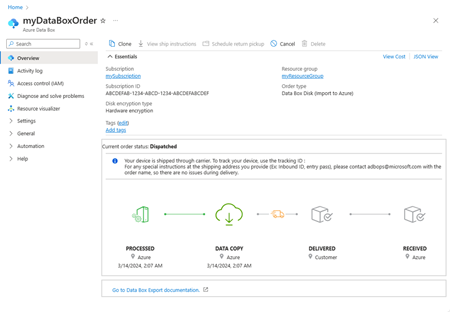
Cancel the order
To cancel this order, in the Azure portal, go to Overview and click Cancel from the command bar.
After placing an order, you can cancel it at any point before the order status is marked processed.
To delete a canceled order, go to Overview and click Delete from the command bar.
Next steps
In this tutorial, you learned about Azure Data Box Heavy topics such as:
- Prerequisites
- Order Data Box Heavy
- Track the order
- Cancel the order
Advance to the next tutorial to learn how to set up your Data Box Heavy.
